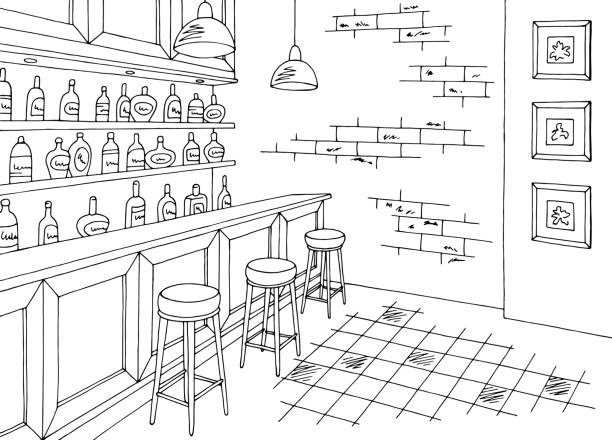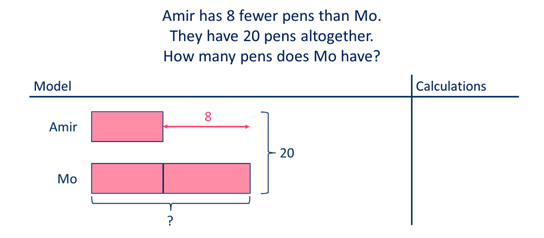Enhance your math lessons using bar model drawing techniques for better comprehension
Wiki Article
Exploring Bar Design Drawing Techniques: A Comprehensive Overview to Visualizing Mathematics Concepts
Bar design attracting methods work as an important source for both teachers and pupils in imagining mathematical principles. These models simplify intricate numerical partnerships, assisting in the comprehension of enhancement, reproduction, division, and reduction. This guide outlines reliable strategies for implementing bar designs, promoting active engagement and real-world connections. As visitors check out the sensible applications and training tips, they will discover exactly how these methods can change their strategy to maths.Understanding the Fundamentals of Bar Version Drawing
Bar model attracting works as an effective visual device in mathematics, facilitating the understanding of analytical methods and mathematical connections. This method entails representing numbers and their connections with rectangle-shaped bars, making it less complicated to picture procedures such as enhancement, multiplication, division, and reduction. Each bar's length represents a details worth, enabling students to contrast amounts and understand proportions clearly.To create a bar model, one starts by determining the problem's vital aspects, typically breaking it down into components that can be aesthetically represented. For example, in a simple addition issue, two bars can be drawn, with their sizes standing for the addends. The consolidated length illustrates the sum. Additionally, bar models can be adjusted for extra complex issues, consisting of portions and ratios, by readjusting benches accordingly. Grasping these basics lays a strong foundation for efficient analytic and much deeper mathematical understanding.
Benefits of Making Use Of Bar Models in Math
Utilizing bar versions in mathematics supplies numerous benefits that boost discovering and comprehension. These aesthetic representations aid pupils in comprehending intricate concepts by damaging them down right into workable elements. Bar versions provide a clear structure for showing partnerships between numbers, making abstract ideas a lot more concrete. They advertise a much deeper understanding of mathematical operations and help with analytic by enabling students to visualize the data they are working with.Bar designs support the advancement of essential thinking skills, as pupils must evaluate and translate the aesthetic details to draw verdicts. This method motivates active engagement with the product, strengthening retention and proficiency of mathematical concepts. By promoting a strong structure in visual literacy, bar versions encourage learners to come close to numerous mathematical difficulties with self-confidence. Generally, the combination of bar designs into mathematics education proves valuable in growing both understanding and analytical abilities amongst pupils.
Using Bar Designs to Enhancement and Subtraction
Bar designs function as an efficient device for visually representing enhancement and reduction problems. By illustrating the connection in between numbers, they improve understanding and facilitate analytical. Additionally, real-life applications of these versions can help students comprehend mathematical concepts in practical contexts.Representing Enhancement Aesthetically
When students run into addition and reduction problems, aesthetic aids can greatly boost their understanding of these operations. Bar designs work as reliable tools for standing for addition. By splitting a rectangle right into segments that correspond to the numbers entailed, students can picture the relationship between the amounts. For instance, if a pupil needs to add 3 and 5, they can create a bar separated into two areas: one area standing for 3 and the various other representing 5. This clear depiction not only simplifies the enhancement process however likewise enhances the concept of incorporating quantities. As trainees control these visual help, they create a much deeper comprehension of addition, bring about improved problem-solving skills and better self-confidence in their mathematical abilities.
Subtraction With Bar Designs
Reduction is often perceived as a much more complicated procedure than enhancement, bar models can effectively clarify this process for students. By visually standing for the amounts entailed, students can much better understand just how numbers connect to each other. In a bar model for subtraction, one bar represents the overall, while another suggests the amount being deducted. This visual distinction assists pupils comprehend the concept of "removing." If a bar reveals 10 systems, and another bar representing 4 systems is removed, trainees can conveniently see that 6 devices stay. This technique not just promotes understanding of subtraction but likewise aids in establishing analytic skills, allowing trainees to imagine their mathematical reasoning and enhance their total comprehension of mathematical concepts.Real-Life Application Instances
Recognizing subtraction via bar designs lays a foundation for applying these methods in real-life scenarios. In various contexts, such as budgeting or shopping, individuals can visualize just how much money remains after expenses. If a person has $50 and invests $20, a bar design can stand for the overall amount and the invested portion, highlighting that $30 is left. Furthermore, parents can make use of bar designs to assist children understand the number of more items need to be contributed to finish a set, such as having 3 apples and needing five. This aesthetic depiction streamlines complicated troubles, assisting in understanding and retention. Ultimately, bar designs work as effective tools in daily decision-making, boosting mathematical understanding in practical circumstances.Envisioning Multiplication and Department With Bar Versions
In exploring the application of bar designs for reproduction and department, it is important to realize their fundamental concepts. Building multiplication versions allows learners to envision connections in between numbers, while efficient department techniques can be highlighted through these visual help. This method boosts understanding and analytic skills in maths.Understanding Bar Versions
Bar designs act as a powerful aesthetic tool for highlighting the ideas of reproduction and division. They make it possible for learners to stand for mathematical partnerships in a structured format, helping with a deeper understanding of these procedures. In multiplication, bar models display teams of equivalent dimension, enabling individuals to visualize the complete quantity when integrating these groups. Conversely, in department, bar versions help show just how a total amount is split into smaller sized, equal parts, making clear the principle of partitioning. By using these aesthetic help, students can grasp the underlying concepts of reproduction and division better. This technique not just improves comprehension yet additionally sustains analytical abilities, making bar designs an important property in mathematical education.Creating Multiplication Designs
Constructing reproduction designs more info utilizing bar diagrams uses a clear technique for picturing the procedure of multiplication. These designs allow students to represent multiplication as groups of equivalent components, making abstract concepts much more concrete. For instance, to show (3 times 4), a pupil can draw one bar divided right into 3 equal sectors, each representing 4 devices. Additionally, creating a second bar with the very same length enhances the understanding of repeated addition, as each section matches to one group. This graph not just aids in grasping reproduction but also enhances analytical skills. By utilizing bar designs, students can much better comprehend partnerships in between numbers and create a robust foundation for more complex mathematical principles, causing raised confidence in their capacities.Envisioning Department Strategies

Solving Word Problems Making Use Of Bar Version Techniques

As an example, in an issue including addition and subtraction, students can attract different bars for every quantity and then manipulate them to locate the remedy. This process not just makes clear the issue but additionally cultivates a deeper theoretical understanding. Bar designs can be adapted for numerous types of word problems, making them versatile throughout various mathematical topics. Ultimately, utilizing bar models can substantially boost students' problem-solving abilities by giving a clear aesthetic pathway to reach the right answer.
Integrating Bar Versions in Different Mathematics Topics
Bar designs can be seamlessly incorporated into numerous math topics, boosting trainees' understanding of concepts past basic math. In algebra, these visual tools help in representing inequalities and equations, allowing learners to imagine connections in between variables. When taking on geometry, bar designs can illustrate the homes of forms and spatial reasoning, assisting pupils understand principles like location and perimeter successfully. In statistics, bar models assist in the analysis of data sets, permitting students to compare amounts and identify trends visually. In addition, incorporating bar models within dimension topics help in recognizing systems and conversions by offering a tangible depiction of quantities. By utilizing bar designs across different mathematical locations, teachers can promote a deeper comprehension of intricate ideas, thus enhancing analytical skills and promoting essential thinking (bar model drawing techniques). This versatility shows the energy of bar designs as a fundamental tool for pupils in their mathematical journeyTips for Training Bar Models Effectively
Incorporating bar models right into teaching methods calls for thoughtful methods to maximize their effectiveness. Educators needs to start by introducing bar versions with simple, relatable examples that students can easily realize. This helps to build self-confidence and experience with the principle. Progressively boosting the complexity of problems permits students to use their abilities considerably. In addition, instructors must encourage students to develop their very own bar models, promoting energetic interaction and ownership of their knowing.Integrating collaborative activities can additionally boost understanding, as pupils review and address problems in teams. Continual responses is essential; instructors should provide positive discourse on trainees' bar design representations to direct improvement. Finally, attaching bar models to real-life circumstances reinforces their significance, aiding trainees see the functional applications of their mathematical skills. By carrying out these techniques, educators can effectively harness the power of bar versions in their mathematics direction.
Regularly Asked Questions
Can Disallow Models Be Utilized in Various Other Subjects Besides Mathematics?
Bar models can indeed be made use of in different subjects beyond math. They efficiently show principles in science, social studies, and language arts, helping to aesthetically represent relationships, procedures, and concepts for improved understanding across disciplines.What Age Team Is Finest Suited for Knowing Bar Designs?
Bar models are best fit for children ages 7 to 12, as they create concrete thinking skills throughout this period (bar model drawing techniques). At this age, students can properly comprehend abstract ideas via visual representation and analytical strategiesAre There Digital Tools for Creating Bar Designs?

How Can I Examine Pupil Recognizing of Bar Models?
Evaluating student understanding of bar versions can include quizzes, observational assessments, and seminar. Educators might also assess students' completed models and their capacity to clarify their thinking, making sure a complete assessment of comprehension.What Are Typical Errors When Using Bar Models?
Usual errors when utilizing bar models consist of misstating amounts, failing to accurately identify bars, puzzling addition and subtraction, disregarding to utilize constant scales, and neglecting the relevance of clear visual separation in between different elements.In addition, bar versions can be adjusted for much more complicated problems, consisting of proportions and portions, by readjusting the bars accordingly. Subtraction is typically viewed as a much more intricate operation than addition, bar versions can successfully clarify this procedure for trainees. In a bar version for subtraction, one bar represents the total, while one more suggests the quantity being subtracted. If a bar shows 10 systems, and another bar standing for 4 units is removed, students can quickly see that 6 systems stay. When dividing an overall into equal teams, trainees can draw a lengthy bar to stand for the entire and then sector it into smaller sized bars that indicate each team.
Report this wiki page